How to Make a Lava Lamp
Lava lamps are a classic science activity that’s super cool. Explore the interactions between oil and water and learn how to make a lava lamp with simple kitchen ingredients.
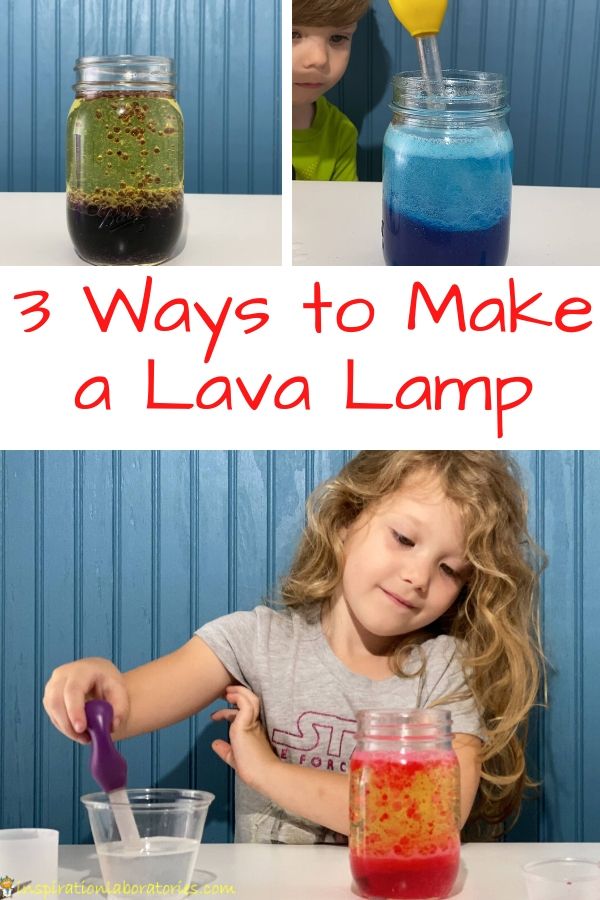
What Is a Lava Lamp?
The original LAVA® Lamp is made from colored wax suspended in a liquid. The base of the lamp is heated by a light bulb. As the colored wax heats up, it becomes less dense and rises. Once the wax reaches the top, it cools down and sinks.
The Science Behind the Lava Lamp Experiment
Instead of using heat and convection to see motion in our lava lamps, we are using chemistry. We are still using differences in density to see movement of the liquids.
Oil is less dense than water. Our lava lamps have an oil layer sitting on top of a water layer. We want our water to bubble up into the oil layer. To do this we are using an acid-base reaction to produce a gas (carbon dioxide).
The gas is less dense than the water and oil. The gas bubbles will rise into the oil layer and take some of the colored water with them. Once the gas rises all the way to the top of the oil, it will exit the oil layer leaving the colored water behind. The colored water is more dense than the oil, so it will sink to the bottom.
DIY Lava Lamp Experiment
How to Make a Lava Lamp with Alka-Seltzer
Your typical lava lamp experiment uses Alka-Seltzer because it requires the least amount of ingredients and is easy.
Materials Needed:
- clear container like a drinking glass, mason jar, peanut butter jar, juice container, or soda bottle
- water (about 1/2 cup)
- cooking oil, mineral oil, or baby oil (1-2 cups – enough to fill your container at least three quarters full
- Alka-Seltzer
- food coloring or liquid watercolors
Instructions:
Fill your clear container about three quarters full with oil.
Next fill the container with water. (You want at least a few inches of water.) The water will sink to the bottom of the container because it is more dense than the oil.
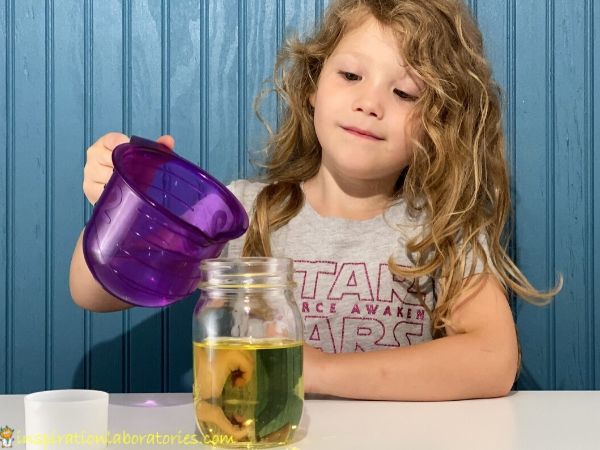
Add 5-10 drops of food coloring. The food coloring will also sink to the bottom.
Break up the Alka-Seltzer into small pieces. Drop one piece into the oil. It will sink into the water layer.
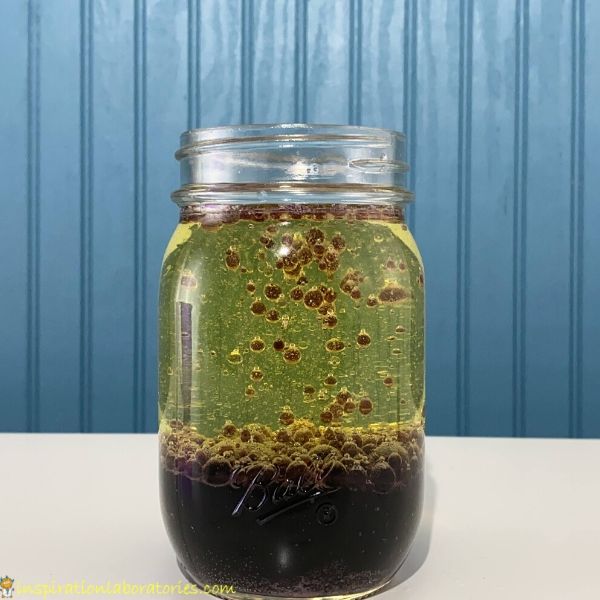
Once the Alka-Seltzer hits the water, it will dissolve. The baking soda (sodium bicarbonate) will react with the citric acid to form water, a salt, and carbon dioxide.
The carbon dioxide will carry some of the colored water up to the surface and you’ll see cool bubbles in the oil layer.
How to Make a Lava Lamp with Baking Soda and Citric Acid
We can replace the Alka-Seltzer with a combination of baking soda and citric acid to achieve the same result.
Materials Needed:
- clear container like a drinking glass, mason jar, peanut butter jar, juice container, or soda bottle
- 2 small containers/cups for mixing
- spoon
- water (about 1 cup)
- vegetable oil, mineral oil, or baby oil (1-2 cups – enough to fill your container at least three quarters full
- baking soda
- citric acid (can also use powdered lemonade or Kool-Aid with citric acid)
- food coloring (skip if using a colorful Kool-Aid)
Instructions:
Add about a tablespoon of citric acid (or powdered lemonade or Kool-Aid) to 1/2 cup of water. Stir.
Add a few drops of food coloring to the water and citric acid (unless you used Kool-Aid).
Add the colored water and citric acid solution to your clear container.
Add oil to your container until it is about three quarters full.
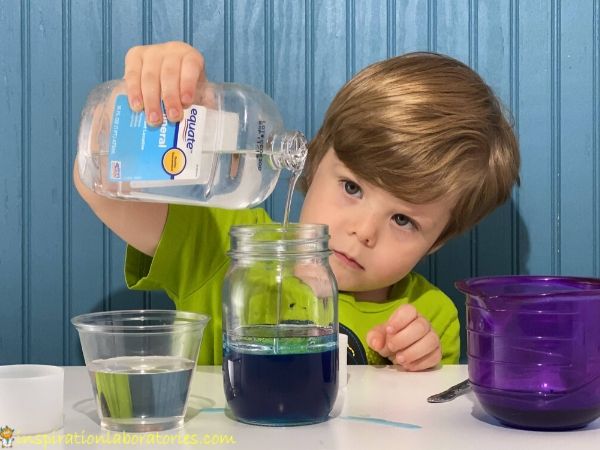
Add a tablespoon of baking soda to another 1/2 cup of water. Stir.
Optional: add a few drops of food coloring to the baking soda and water solution.
Drop a spoonful of the baking soda and water solution onto the oil layer.
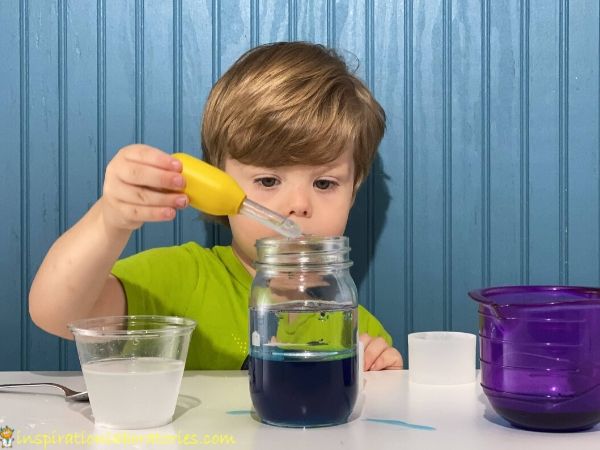
The baking soda and water solution will sink into the water layer.
The baking soda (sodium bicarbonate) will react with the citric acid in the colored water to form water, a salt, and carbon dioxide.
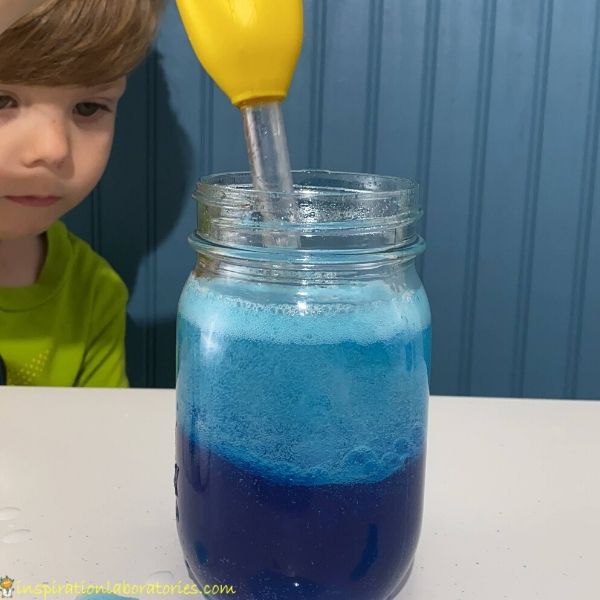
The carbon dioxide will carry some of the colored water up to the surface and you’ll see cool bubbles in the oil layer.
If you colored your baking soda and water solution, you will see color mixing as well.
How to Make a Lava Lamp with Baking Soda and Vinegar
We can use baking soda and vinegar to create the same reaction.
Materials Needed:
- clear container like a drinking glass, mason jar, peanut butter jar, juice container, or soda bottle
- 2 small containers/cups for mixing
- spoon
- water (about 1/2 cup)
- vegetable oil, mineral oil, or baby oil (1-2 cups – enough to fill your container at least three quarters full
- baking soda
- vinegar
- food coloring
Instructions:
Fill your clear container about three quarters full with oil.
Next add vinegar to the container. (You want at least a few inches of vinegar.) The vinegar will sink to the bottom of the container because it is more dense than the oil.
Add 5-10 drops of food coloring. The food coloring will also sink to the bottom.
Add a tablespoon of baking soda to a 1/2 cup of water. Stir.
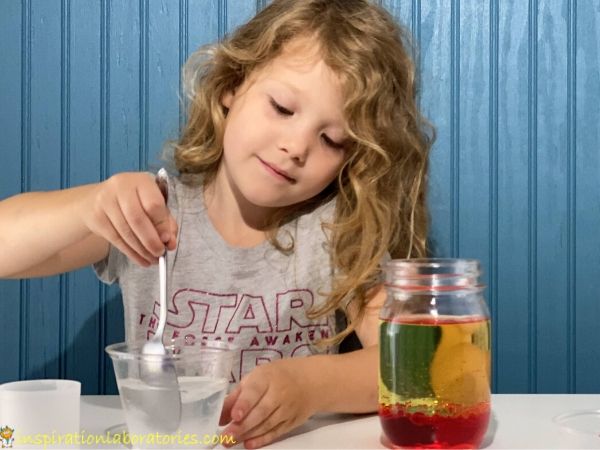
Optional: add a few drops of food coloring to the baking soda and water solution.
Drop a spoonful of the baking soda and water solution onto the oil layer.
The baking soda and water solution will sink into the water layer.
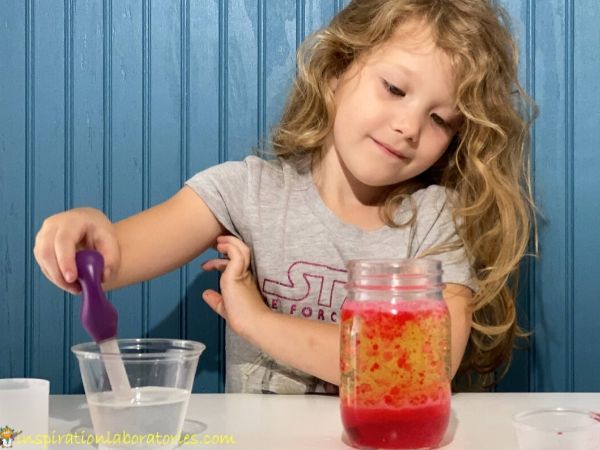
The baking soda (sodium bicarbonate) will react with the vinegar to form water, a salt, and carbon dioxide.
The carbon dioxide will carry some of the colored water up to the surface and you’ll see cool bubbles in the oil layer.
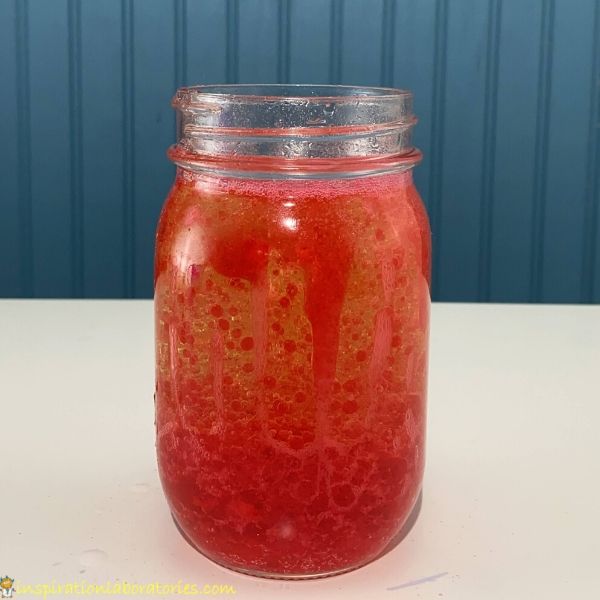
If you colored your baking soda and water solution, you will see color mixing as well.
More Science Experiments with Density Layers
Explore what happens when you mix oil and water.
Learn about mixtures and find out what makes a good emulsifier.
Try a saltwater density investigation.
Use fruit juice in our layering liquids density experiment.
Subscribe to the Inspiration Laboratories newsletter. Each issue has exclusive hands-on science explorations for children, a recap of our latest activities, and special resources selected just for you!

Leave a Reply